University of Surrey (UNIS)
Latest uploads at University of Surrey (UNIS). Looking for notes at University of Surrey (UNIS)? We have lots of notes, study guides and study notes available for your school.
-
215
-
3
-
13
Majors at University of Surrey (UNIS)
Notes available for the following studies at University of Surrey (UNIS)
-
Biomedical Sciences 7
-
Tourism and Management 1
-
University of Surrey 50
Popular books University of Surrey (UNIS)

Institution Of Civil Engineers • ISBN 9780727764409
Latest notes & summaries University of Surrey (UNIS)
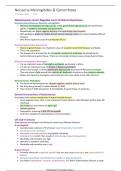
Explore the taxonomy, morphology, and biochemical properties of Neisseria meningitidis and Neisseria gonorrhoeae, highlighting their unique characteristics that distinguish them from other bacterial pathogens. Gain insights into the mechanisms of infection for both bacteria, including the virulence factors that enable them to evade the host immune system, cause disease, and establish infection.
- Package deal
- Class notes
- • 5 pages's •
-
University of Surrey•Cellular Microbiology And Virology
-
Comprehensive Notes on Cellular Microbiology and Virology• ByLakuscholars
Preview 2 out of 5 pages
Explore the taxonomy, morphology, and biochemical properties of Neisseria meningitidis and Neisseria gonorrhoeae, highlighting their unique characteristics that distinguish them from other bacterial pathogens. Gain insights into the mechanisms of infection for both bacteria, including the virulence factors that enable them to evade the host immune system, cause disease, and establish infection.
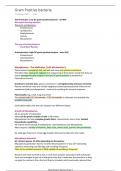
Explore the fundamental features that distinguish Gram-positive bacteria from Gram-negative bacteria, including cell wall structure, staining properties, and biochemical characteristics. Gain insights into the major genera of Gram-positive bacteria, including Staphylococcus, Streptococcus, Bacillus, and Clostridium, with descriptions of their morphology, physiology, and pathogenic potential. Understand the mechanisms of infection and virulence factors associated with key Gram-positive path...
- Package deal
- Class notes
- • 2 pages's •
-
University of Surrey•Cellular Microbiology And Virology
-
Comprehensive Notes on Cellular Microbiology and Virology• ByLakuscholars
Preview 1 out of 2 pages
Explore the fundamental features that distinguish Gram-positive bacteria from Gram-negative bacteria, including cell wall structure, staining properties, and biochemical characteristics. Gain insights into the major genera of Gram-positive bacteria, including Staphylococcus, Streptococcus, Bacillus, and Clostridium, with descriptions of their morphology, physiology, and pathogenic potential. Understand the mechanisms of infection and virulence factors associated with key Gram-positive path...
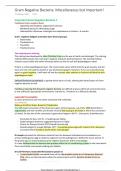
Learn the distinguishing features of gram-negative bacteria, including their unique cell wall structure, which influences their staining properties and pathogenicity. Explore important gram-negative bacterial genera such as Escherichia, Salmonella, Pseudomonas, and Neisseria, along with their clinical significance and roles in human health.
- Package deal
- Class notes
- • 4 pages's •
-
University of Surrey•Cellular Microbiology And Virology
-
Comprehensive Notes on Cellular Microbiology and Virology• ByLakuscholars
Preview 1 out of 4 pages
Learn the distinguishing features of gram-negative bacteria, including their unique cell wall structure, which influences their staining properties and pathogenicity. Explore important gram-negative bacterial genera such as Escherichia, Salmonella, Pseudomonas, and Neisseria, along with their clinical significance and roles in human health.
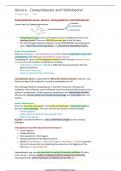
Understand the morphology, physiology, and genetic makeup of Campylobacter and Helicobacter. Learn about their unique characteristics, growth requirements, and metabolic pathways. Explore the mechanisms of pathogenesis for both genera, including virulence factors and how these bacteria evade host defenses. Gain insight into the diseases associated with each, such as gastroenteritis from Campylobacter jejuni and peptic ulcers from Helicobacter pylori.
- Package deal
- Class notes
- • 3 pages's •
-
University of Surrey•Cellular Microbiology And Virology
-
Comprehensive Notes on Cellular Microbiology and Virology• ByLakuscholars
Preview 1 out of 3 pages
Understand the morphology, physiology, and genetic makeup of Campylobacter and Helicobacter. Learn about their unique characteristics, growth requirements, and metabolic pathways. Explore the mechanisms of pathogenesis for both genera, including virulence factors and how these bacteria evade host defenses. Gain insight into the diseases associated with each, such as gastroenteritis from Campylobacter jejuni and peptic ulcers from Helicobacter pylori.
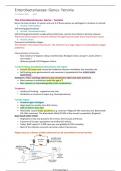
Detailed exploration of Yersinia morphology, structure, and classification within the Enterobacteriaceae family. Insight into the mechanisms of infection, virulence factors, and the host immune response to Yersinia infections. Comprehensive discussion on the symptoms, diagnosis, and treatment options for infections caused by Yersinia.
- Package deal
- Class notes
- • 4 pages's •
-
University of Surrey•Cellular Microbiology And Virology
-
Comprehensive Notes on Cellular Microbiology and Virology• ByLakuscholars
Preview 1 out of 4 pages
Detailed exploration of Yersinia morphology, structure, and classification within the Enterobacteriaceae family. Insight into the mechanisms of infection, virulence factors, and the host immune response to Yersinia infections. Comprehensive discussion on the symptoms, diagnosis, and treatment options for infections caused by Yersinia.
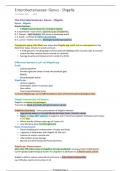
Explore the four main species—Shigella dysenteriae, Shigella flexneri, Shigella boydii, and Shigella sonnei—along with their unique characteristics. Learn about the transmission routes of Shigella, highlighting its infectious nature and public health significance. Understand how Shigella invades intestinal epithelial cells, the role of virulence factors, and the resulting inflammatory response.
- Package deal
- Class notes
- • 2 pages's •
-
University of Surrey•Cellular Microbiology And Virology
-
Comprehensive Notes on Cellular Microbiology and Virology• ByLakuscholars
Preview 1 out of 2 pages
Explore the four main species—Shigella dysenteriae, Shigella flexneri, Shigella boydii, and Shigella sonnei—along with their unique characteristics. Learn about the transmission routes of Shigella, highlighting its infectious nature and public health significance. Understand how Shigella invades intestinal epithelial cells, the role of virulence factors, and the resulting inflammatory response.
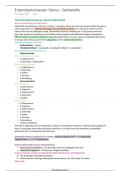
Explore the morphology, serotypes, and classification of Salmonella species, including S. enterica and S. typhi. Gain insight into the modes of transmission, reservoirs, and global public health significance of Salmonella infections. Detailed explanation of how Salmonella invades the host, its virulence factors, and the immune response it triggers.
- Package deal
- Class notes
- • 3 pages's •
-
University of Surrey•Cellular Microbiology And Virology
-
Comprehensive Notes on Cellular Microbiology and Virology• ByLakuscholars
Preview 1 out of 3 pages
Explore the morphology, serotypes, and classification of Salmonella species, including S. enterica and S. typhi. Gain insight into the modes of transmission, reservoirs, and global public health significance of Salmonella infections. Detailed explanation of how Salmonella invades the host, its virulence factors, and the immune response it triggers.
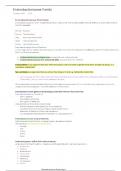
Understand the defining features of Enterobacteriaceae, including their Gram-negative structure, facultative anaerobic nature, and metabolic diversity. Detailed coverage of the most common infections caused by this bacterial family, from gastroenteritis to urinary tract infections, pneumonia, and septicemia.
- Package deal
- Class notes
- • 3 pages's •
-
University of Surrey•Cellular Microbiology And Virology
-
Comprehensive Notes on Cellular Microbiology and Virology• ByLakuscholars
Preview 1 out of 3 pages
Understand the defining features of Enterobacteriaceae, including their Gram-negative structure, facultative anaerobic nature, and metabolic diversity. Detailed coverage of the most common infections caused by this bacterial family, from gastroenteritis to urinary tract infections, pneumonia, and septicemia.
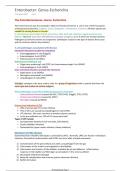
This document provides a thorough and detailed overview of the Enterobacter genus and the Escherichia species, with a specific focus on Escherichia coli (E. coli). Ideal for students studying microbiology, medical sciences, or biotechnology, these notes offer in-depth explanations of the key characteristics, functions, and clinical significance of these bacteria.
- Package deal
- Class notes
- • 4 pages's •
-
University of Surrey•Cellular Microbiology And Virology
-
Comprehensive Notes on Cellular Microbiology and Virology• ByLakuscholars
Preview 1 out of 4 pages
This document provides a thorough and detailed overview of the Enterobacter genus and the Escherichia species, with a specific focus on Escherichia coli (E. coli). Ideal for students studying microbiology, medical sciences, or biotechnology, these notes offer in-depth explanations of the key characteristics, functions, and clinical significance of these bacteria.
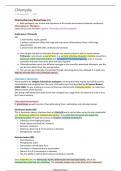
A complete overview of the genus Chlamydia, its classification, and key species (Chlamydia trachomatis, Chlamydia pneumoniae, etc.), emphasizing its unique features as an obligate intracellular bacterium. Explore the mechanisms of Chlamydia infection, including how it invades host cells, evades immune defenses, and causes damage to tissues.
- Package deal
- Class notes
- • 3 pages's •
-
University of Surrey•Cellular Microbiology And Virology
-
Comprehensive Notes on Cellular Microbiology and Virology• ByLakuscholars
Preview 1 out of 3 pages
A complete overview of the genus Chlamydia, its classification, and key species (Chlamydia trachomatis, Chlamydia pneumoniae, etc.), emphasizing its unique features as an obligate intracellular bacterium. Explore the mechanisms of Chlamydia infection, including how it invades host cells, evades immune defenses, and causes damage to tissues.
